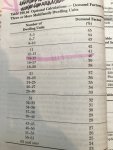Also in example say I have a two story home with a living space in the basement and the whole house has a 200amp service. And I place a new 100 sub panel in the basement for the new living space(seeing that load calculations permit to have room for this). Since the panel is going to supply the whole new living space it would be correct to use the 83% rule for the conductors feeding the sub panel?
Good question.
The answer is that the 83% rule and associated table would not apply. The scope of where it can apply, is a narrow window: single dwelling unit, and its entire load only. It doesn't apply for the collective service before diverging the current among multiple dwelling units, it doesn't apply if the application isn't a residence, and once you diverge circuits within a dwelling unit, it no longer applies. The rules for feeder conductor sizing, would apply instead.
Consider the following example, with each device numbered:
1. The service point of a 200A service for a single family home
2. A hot sequence self-contained meter on the outside wall
3. The main service disconnect the outside wall. Could be either a fused switch, or a breaker. In any case, all current going in this device, will go outward to device #4.
4. A 200A main panel is inside on the first floor
5. A 100A subpanel in the basement, fed from a branch circuit of device #4
Between devices 1 and 2, as well as devices 2 and 3, the conductors classify as service conductors. They only feed a single family dwelling unit, and carry the complete load. The 83% rule applies.
Between devices 3 and 4, the conductors cease to be classified as service conductors, and now classify as a feeder. Due to the fact this circuit is directly in series with the service conductors, without any brached paths yet, it feeds a single family dwelling unit, and carries the complete load. The 83% rule still applies.
Between devices 4 and 5, the conductors classify as a feeder. However, because the main panel has local loads within it, this feeder no longer carries the complete load of the dwelling unit. It only carries a portion of the dwelling unit's load, that which is specific to the basement. The 83% rule does not apply.


